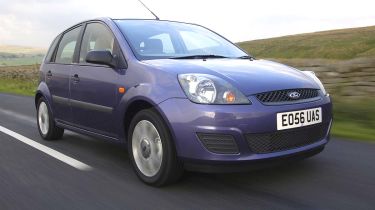Ford Fiesta 1.4 Style Climate
Ford's Fiesta is the oldest major contender in the supermini class, but is still a big seller
A mild makeover earlier this year brought new lights front and rear, but the model does look old-fashioned in this company. The black plastic door handles and mirrors don’t help, as they cheapen the design – although higher-spec cars get body-coloured items. Either way, both three and five-door Fiestas appear boxy, and the low roofline shows how the Ford is being left behind by newer, bigger rivals. Only the Yaris has a shorter wheelbase.
Nevertheless, rear passenger room is similar to the Peugeot, and the back seats fold and tumble. The 284-litre boot capacity isn’t too far behind, either, but the lack of an external release is a pain, and means the hatchback can only be opened via the key or a button on the dash.
Up front, the driving position is roomy enough, while the seats are comfortable and supportive. And although the steering wheel doesn’t adjust for reach, the high-mounted gearlever is well placed. A new dashboard layout was introduced as part of the recent updates, and now the upper section is made from soft-touch material. But it can’t hide the fact that the design itself is dated. vAlthough the big-button stereo is easy to use, the heater controls are a bit low rent and stowage is in short supply compared to the practical Yaris.
Used - available now

2016 BMW
5 Series
107,200 milesAutomaticDiesel2.0L
Cash £9,000
2023 Audi
e-tron
48,154 milesAutomaticElectric
Cash £18,000
2015 Volkswagen
Golf GTD
84,621 milesAutomaticDiesel2.0L
Cash £12,000
2016 Tesla
Model S
78,000 milesAutomaticElectric
Cash £18,999Still, while the cabin is clearly beginning to show its age, the Fiesta continues to deliver plenty of entertainment on the road. The chassis has stood the test of time, and the blend of ride and handling remains biased towards fun.
The Ford’s steering is nicely weighted, precise and fluid, so with sharp turn-in and levels of feedback that outclass its newer rivals’, the car feels alive in comparison. There is a little kickback when cornering over rough surfaces, but the lively responses make the Fiesta agile and involving. And while it can’t match newer superminis for ultimate grip, over a twisty road the car raises the biggest smile. Our only criticisms concern the ride, which isn’t as composed as the Renault’s, while the Ford is also noisier than the Vauxhall at speed.
But it’s easy to drive, and the five-ratio gearbox has the slickest shift here. The brakes were the best performers in our 60-0mph test, too – stopping the car in 36.4 metres – so dynamically the Fiesta still has the ability to live with the best in class.
Where the Ford really shows its age is under the bonnet; its 78bhp 1.4-litre engine is the least powerful on test. At the track, it still propelled the car from 0-60mph in 12.5 seconds, which is two-tenths-of-a-second faster than the Corsa and the same as the 207. But in-gear performance was poor – it recorded the slowest 50-70mph time in fifth – and the motor has to be worked hard to get that pace. As a result, engine noise is much more noticeable than it is in either the Corsa or Clio.
At £9,890, the Ford is the cheapest car of our five, but when you look at the kit list, you realise why. Only two airbags are standard, and alloys are optional. The £275 Reflex Pack adds side and curtain airbags, plus a centre rear headrest, but while this boosts safety, the Fiesta has only a four-star Euro NCAP crash test rating. What’s more, stability control is available solely on the flagship ST model.
Details
Price: £9,890
Model tested: Ford Fiesta 1.4 Style Climate
Chart position: 5
WHY: The oldest car on test, the Fiesta was recently facelifted inside and out. It’s still a big seller, with a total of 38 models in the range and a choice of four petrol powerplants and two diesels. The £9,890 three-door Style is the cheapest car in our line-up, although again we’ve used a five-door for our pictures.
Economy
Despite having the smallest output, the Fiesta was less frugal than the Yaris. We recorded 36.9mpg. With a 45-litre fuel tank, that means a 365-mile range.
Residuals
Sold in large numbers and the oldest car here, the Fiesta has the worst residuals – but only just. It’s a mere 0.1 per cent behind the Clio.
Servicing
Ford has the biggest franchise network – and 12,500-mile intervals mean the Fiesta will need a lot of servicing. A one-year recovery deal disappoints.







